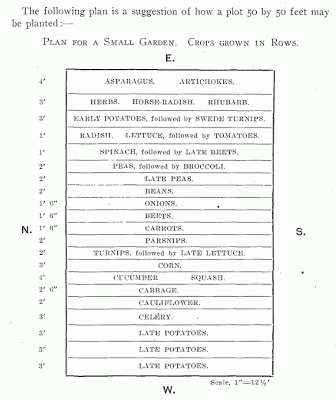Biosecurity Guidelines for Post - harvest Greenhouse Tomatoes: Prevention of Post - harvest and Storage Rot - March 27, 2013
Link to Ron Finley Ted Talk Plants vegetables garden south central LA
Updated 2024-03-05 via the WayBackMachine
In earlier days, like the 1920's, there were more important objectives.... SURVIVAL of the fittest and we're not just talking about Tomatoes alone.
The City of Vancouver was incorporated on April 6, 1886, the same year that the first transcontinental train arrived. There was no Costco or Safeways, maybe a "corner store" here and there, but if you had land, and there was lot of that around per capita, for the taking, then you could have your own source without depending upon California and a link via a Skagit River crossing.
All you needed was a 50' X 50' plot of land dedicated to your garden... Another 50' X 100' for the house and stable.
 |
| Gardening on a City Lot in BC |
January and February, kale, parsnips, leeks, lettuce, and parsley;
March,spinach and broccoli;
April, radish, onions, rhubarb, and broccoli;
May, asparagus and peas;
June, early cabbage, carrots, and beets;
July, early potatoes, parsnips, and beans;
August, tomatoes, cauliflower, onions, cucumbers, and summer squash;
September, cabbage, salsify, and herbs;
October, celery, brussels sprouts, leeks, and winter squash;
November, fall lettuce and early spinach;
December, same as for January and February.
Besides the fresh vegetables which may be had through the winter months, the gardener can have a large variety stored, including potatoes, beets, carrots, onions, celery, squash, and turnips.
In 1921 the BC Government pegged the costs of food shopping at Thirty-Five cents a day One Hundred Twenty Seven and 75/100 Dollars per year.
2013, taking into account Inflation.... that works out to $1,536.76 ..... per year. Does that sound about right?
Or does it mean that the Bank of Canada Inflation bean counters software is out of whack, has been out of whack for a long time.
The early settlers but later than 1886, following the First World War, were encouraged to come to Canada, to British Columbia where they had to clear the trees, the stumps, plow the land, seed the fields, tend the fields, harvest the field, and have the resources, FOOD to last until the next year ..... like these Links to previous Posts here at the BBC.
Soldiers and Raspberries, Stalwart Peasant, Oats, Wheat and Barley Grows. Firsts for Women, Taxes and Tolls, Pigeon Phones, 125 year old Vancouver, Tom Carter Gallery, Len Norris, Warner Loat, Trutch
Were City Lots dimensions determined by the need of its residents to fend for themselves, wholly dependent upon the land? Were the backyard buildings still housing stables for horses, soon to be replaced by cars... which didn't create manure for the garden? Up until 1950's Dairyland delivered their milk by HORSE... the manure was fantastic.... so Mr. D (our neighbour) used to say.... D is for Davis....
Today's residential Front Yards, now they could be used for a vegetable garden..... 26' setback X 50' wide or 33' wide... as long as there are not Horse Chestnut Trees growing on the front street .... would the southern facing street front yards have more daylight than the their Northern facing front yards .... all depends on the size of the house, not by today's standards, but pre 1921.... is there an inflation counter for buildings...
A greenhouse would help....

1 comment:
We still shop for food, but there is something in the yard all around, and probably the healthiest part of the diet lies right there. It still needs to evolve, as we're using RD water and still bring in manure and he occasional bale of straw. I'm a toolaholic, so there's more cash out the door. But if we had to eat out of the yard, I'd sure be slimmer and probably healthier. Along the way, some of us are trying to get others involved in really local food, in sharing, in seed-saving and all manner of resilience training. Thanks for this and for all the other matters you address.
Post a Comment